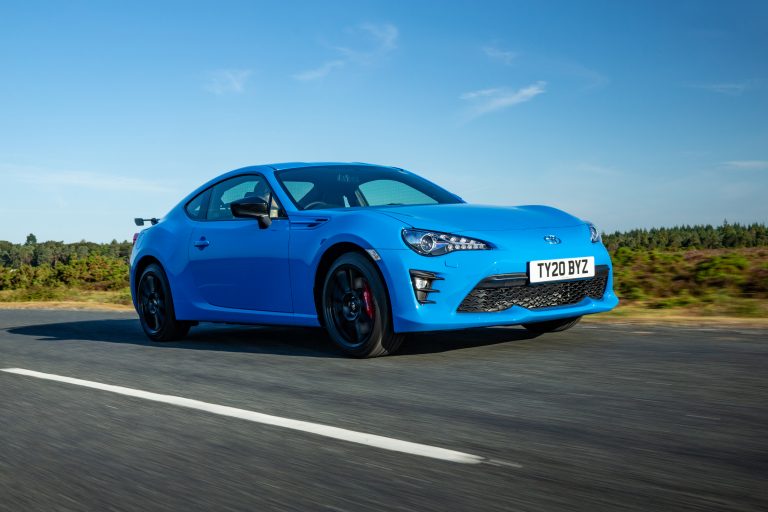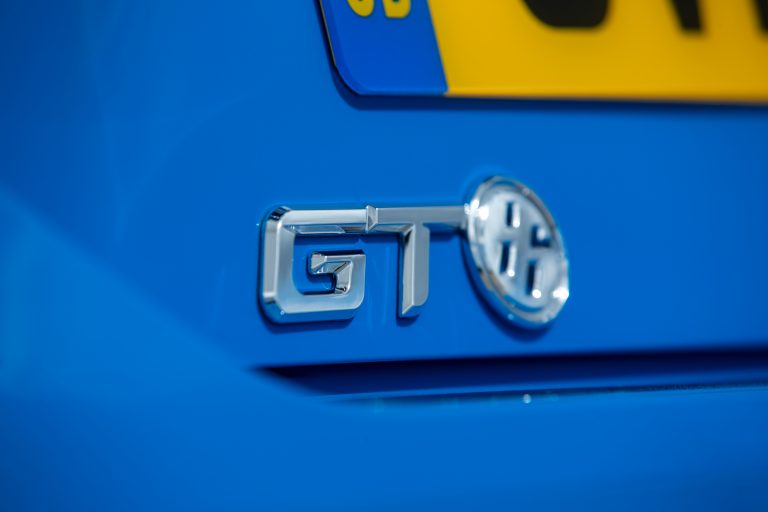The 2017 Toyota GT86 (European media launch)
This press kit was issued for the European media launch of the revised, 2017 Toyota GT86. The contents are UK-specific and cover all the upgrades and improvements made to the car. For the full GT86 press kit, please go to the GT86 home page on the Toyota UK media website here.
Full gallery of photographs from the launch can be downloaded from here.
INTRODUCTION
In creating GT86, Toyota set out to engineer a car that captures the purest pleasures of driving, a coupe that is simple, focused and, above all, fun. As a distillation of the classic sports car qualities of compact size, agile handling, responsiveness and driver feedback, it has fulfilled its promise, gaining the acclaim of critics and enthusiasts alike and achieving more than 170,000 worldwide sales since its launch in 2012.
Inspired by Toyota’s fine sports car heritage and models such as the 2000GT and AE86 Corolla, GT86 has equally taken on the role of a pathfinder for Toyota’s mission to build cars that are genuinely more engaging and rewarding to drive. It’s a direction promoted from the top by Toyota President Akio Toyoda, who declared that “if it’s not fun to drive, it’s not a car”.
GT86 conforms to the classic sports car template in being compact, lightweight, having a low centre of gravity and a front engine/rear-wheel drive configuration. The powertrain broke new ground, in adopting a high-revving 2.0-litre, naturally aspirated, horizontally opposed “boxer” four-cylinder engine, produced by Subaru and equipped with Toyota’s D-4S direct fuel injection.
The car has proved its quality on road, track and rally stage. In fact, valuable data and feedback were gained from its performance in the gruelling arena of the Nürburgring 24 Hours with Toyota Gazoo Racing, in order to shape the changes and improvements now being introduced for the 2017 model – the first significant changes to the car.
In rallying, Toyota Motorsport’s development of the GT86 CS-R3 has brought the excitement of rear-wheel drive back to the sport in a car that is practical and affordable for grass-roots enthusiasts, yet homologated to compete at all levels up to the World Rally Championship.
2017 GT86
Under the skin there have been detailed adjustments to the suspension and damping, targeting improvements in handling, stability and ride comfort. Measures have also been taken to increase body rigidity.
One of the most significant developments in the 2017 GT86 from a driver’s point of view is a new Track mode, giving them the opportunity to enjoy performance driving with minimum intervention of electronic Vehicle Stability Control and traction control systems. The car’s new multi-information display gives real-time access to power and torque curves, G-forces and a stopwatch to chart successive lap times.
The addition of the Track mode is one element in an extensive reappraisal of GT86’s electronic control and handling systems, including the performance of the ABS and traction control. Chief Engineer Tetsuya Tada considers that these revisions in fact deliver the most significant changes in the car’s handling potential, making good use of information gained from the coupe’s participation in motorsport.
In design terms, the new car is not a radical departure from the original, but rather matures its established styling, reinforcing its low and wide sporting stance. The changes include new LED headlight units with integrated LED daytime running lights and turn indicators, a lower nose and a revised front bumper. At the rear there is a new full-width, wing-type spoiler. Every change – even the smallest detail – has contributed to better aerodynamic performance, under the instruction of Chief Engineer Tada.
Customer feedback has also informed the revisions to the coupe, in particular in the cabin, where new trim and upholstery materials take the sensory quality to a higher level and a new small-diameter steering wheel generates an even stronger connection between driver and car.
Together these changes combine in a car that stands as an even stronger expression of the guiding principles that define GT86 as an authentic, high-quality driver’s car.
IMPROVED DRIVING DYNAMICS
- Suspension adjusted for improved handling, stability, ride comfort and turning performance
- New Track mode for sports driving with minimum Vehicle Stability Control and traction control intervention
- Strategic changes to achieve higher body rigidity and durability
- Design details to enhance aerodynamic performance, including new wing-type rear spoiler
Front suspension
The MacPherson strut front suspension benefits from pinpoint adjustments to deliver improved handling, stability and ride comfort and better steering feel.
Focusing on the performance of the coil springs, the spring rates have been optimised and the axis load control system has been engineered to reduce the difference in steering force on the left and right hand sides. The springs are also able to flex as well as compress, helping produce a smooth and easy-to-control steering feel.
The Showa shock absorbers have been revised, too, with the sliding surface of the guide bushing changed to provide better friction characteristics, contributing to the car’s improved handling and stability. Damping force has been reduced to gain an improvement in ride comfort.
Rear suspension
Changes in the rear double wishbone suspension target turning performance as well as gains in handling and stability, achieved through optimised coil spring rates and the same changes to the shocks as featured in the front suspension.
An increase in the diameter of the rear anti-roll bar contributes to better turning performance, together with a change in the distribution of longitudinal body roll.
Enhanced body rigidity
The rigidity of GT86’s body is key to its rewarding handling and driveability, an area addressed by careful use of different high-tensile steels to achieve strength, torsional stiffness and light weight within the body shell. The bonnet is made from sheet aluminium and the wings from thinner sheet steel, helping minimise the coupe’s weight.
Small but telling measures have been taken to improve body rigidity and vehicle durability further in the 2017 GT86, including a thicker mounting bracket for the front suspension towers, a thicker reinforcement in the transmission crossmember and additional reinforcements in the rear wheel arches with additional weld points. The centre and front of the rear panel have also been made significantly thicker.
New Track mode
True to the concept that GT86 should deliver the purest driving enjoyment, Toyota has adjusted the Vehicle Stability Control system to add a new Track mode in which the driver is given an even greater range of handling, braking and turning control for genuine and highly enjoyable sports driving.
The Track setting is activated using a switch on the centre console, illuminating an indicator lamp in the driver’s multi-information display. This turns the VSC and the car’s traction control (TRC) to a minimum level, removing a layer of electronic intervention so the driver can apply their own car control skills for a more engaging experience at the wheel.
Adding Track mode gives the driver a choice of four VSC and TRC settings. In normal driving both systems operate, while TRC can be switched off to help when pulling away on rough surfaces. The VSC Sport mode expands the permissible range of lateral acceleration and movement before the system intervenes, allowing the driver to explore the limits of the car’s dynamics without sacrificing stability.
The introduction of the Track mode is part of a detailed re-evaluation of the role electronic control systems can play in enhancing GT86’s handling performance. Making direct use of data gathered from the car’s participation in motorsport events, such as the Nürburgring 24 Hours, fine adjustments have been made to systems including the ABS and traction control – changes that Chief Engineer Tada thinks can help drivers fully exploit their skills and unlock the car’s full potential.
Aerodynamic performance
GT86 retains the benefits of the “aero-sandwiching” concept, in which the pressure of air flow over, beneath and along the sides of the car serves to keep it vertically and horizontally stable, without generating unnecessary downforce and without increasing its 0.27 coefficient of drag. The contours of the “pagoda” roof play an important role in this, a treatment that is mirrored in the surfacing of the car’s underbody.
Chief Engineer Tada required that any exterior design changes should have a positive effect on the vehicle’s handling and stability, down to the finest detail. In the front bumper a new blocking surface has been added below the front grille, with two distinctive “teeth,” and the lower edge of the bumper has been angled to 45 degrees to help generate a better airflow. Similarly the lower edge of the rear diffuser has also been set at a 45-degree angle.
The new wing-type rear spoiler has a positive impact on both aerodynamic performance and stability. It extends the full width of the rear of the car and is fitted with end plates which work with the vertical mounts to help create a wraparound airflow. The flow of air over and under the wing generates a downforce effect to help keep the car stable at speed.
Powertrain
GT86’s powertrain is unchanged, retaining its unique format of a high-revving, naturally aspirated 2.0-litre, horizontally opposed “boxer” engine driving the rear wheels. Toyota added its D-4S direct fuel injection technology to the Subaru-sourced engine, securing increased throttle response, power and torque over a wide range of engine speeds.
Driving the rear wheels through a six-speed manual or automatic transmission, the 1,998cc 16-valve DOHC unit produces a maximum 197bhp/147kW at 7,000rpm and 205Nm of torque between 6,400 and 6,600rpm. Nought to 62mph acceleration can be achieved in 7.6 seconds with manual transmission, 8.2 seconds for the automatic.
EXTERIOR STYLING
- Exterior styling changes evoke a mature look that projects agility and a low and wide vehicle stance
- New LED headlights with integrated turn indicators emphasise strong horizontal lines
- Lower-set nose with revised front bumper
- New 17-inch 10-spoke alloy wheel design
- New rear light clusters with LED lamps and lightguides
The detail changes made to GT86’s exterior styling have not been introduced to create a different look; rather they serve to develop the car’s established appearance, adding maturity and eliciting an even stronger sporting look. Throughout the design programme, Toyota has remained faithful to the concept of combining contemporary lines with visual references to models from its illustrious sports car heritage, not least the 2000GT.
New frontal design
These goals achieve perfect harmony in a subtle but effective reworking of the frontal elements, notably with a wider, low-set grille, a pronounced lower lip to the front bumper with integrated fins and a lowering of the tip of the car’s nose. This refreshed head-on-view amplifies the car’s ground-hugging stance and agile performance.
Aerodynamic detailing extends to a subtle new nose fin and new LED fog lamp surrounds with a triple-strake design that is both aerodynamically efficient and striking in appearance. The headlight units have been restyled to create a stronger horizontal emphasis, with new bi-LED lamps for full and high beam. The turn indicators have been relocated from the far edges of the front bumper to within the headlamp clusters, arranged as a line of individual orange LEDs beneath an angled series of white daytime running light LEDs. The result is the generation of a stronger horizontal axis across the front of the vehicle, emphasising its width and maturity of design.
Reasserting the coupe profile
GT86 retains its distinctive coupe silhouette, complete with “pagoda” roof design, low centre of gravity and door apertures that evoke the look of the two-seater 2000GT, successfully applied to a compact 2+2 sports car format. The vehicle retains its 4,240mm overall length, 1,320mm height (with shark fin antenna), 1,775mm width and 2,570mm wheelbase.
In profile view, the areas forward of the front wheels and aft of the rear wheels have been shaped to generate a stronger sense of sporting performance. The wing garnish has a new integrated fin that contributes to controlling body roll, true to Chief Engineer Tetsuya Tada’s intention that all styling changes should serve a practical purpose in terms of improving the vehicle’s aerodynamic performance.
New 17-inch wheel design
A new 17-inch cast alloy wheel design has been produced for GT86, featuring 10 ultra-slim spokes with a contrast bright and gun metal grey machined finish to provide an agile and strongly defined 3D appearance.
Stronger rear styling
New features at the rear of the car follow the pattern of those at the front in generating a lower, stronger look, led by a wider and deeper black moulding and diffuser unit that creates a strong trapezoidal shape and extends low enough to conceal the exhaust silencer.
The new wing-type rear spoiler replaces the previous integrated component design, projecting a sportier look as well as contributing to GT86’s improved aerodynamics.
The rear LED light clusters have been reworked, generating a stronger horizontal line and using light guides to produce a distinctive lighting signature. They also feature new LED turn indicators.
INTERIOR STYLING AND EQUIPMENT
- New small diameter, multi-function steering wheel
- New 4.2-inch colour TFT multi-information display
- Latest iteration of Toyota Touch 2 with Go multimedia and navigation system with 6.1-inch touchscreen
- Focus on higher levels of sensory quality
- New trim and upholstery materials
Changes made to GT86’s cabin serve to emphasise the car’s genuine sporting quality while raising the functionality and the visual and tactile quality of the interior. The focus remains the business of driving, but in an environment that is even more appealing to the eye and touch.
Toyota’s smallest steering wheel
Particular attention has been paid to the size and shape of the steering wheel to provide the best grip and action for the driver. Retaining the sporty three-spoke design, Toyota has reduced the diameter by 3mm to 362mm, making it the smallest it has yet featured on a Toyota production car. The wheel’s weight has also been reduced by 10 per cent.
The cross-section of the rim has been precision calculated so that when the driver holds the wheel, their arms are naturally angled slightly inwards, promoting a sportier feel.
More emphasis has been added to the look of the wheel with sculpted, metal-effect spokes and a prominent, silvered 86 logo on the centre boss. The new wheel also incorporates switches to adjust the new 4.2-inch colour TFT multi-function display and audio system.
Multi-information display
The driver’s instrument display has been revised with a new triple-dial arrangement that includes a new 4.2-inch colour TFT multi-information read-out, providing real-time data that can be called up and adjusted with ease using the new control switches on the steering wheel.
As well as familiar information such as fuel economy, journey details, coolant temperatures and cruising distance, the display can also present more performance driving-focused details, including a G-force monitor, power and torque curves, a stopwatch and lap times in sequence.
The multi-information display presents the 86 logo each time the car is started and also provides driver alerts, including door ajar and low coolant warnings.
The tachometer has been reoriented so that 7,000rpm – the engine speed at which peak power is delivered – now sits at the top of the dial.
Centre console with touchscreen display
A new 6.1-inch touchscreen display has been introduced in the centre console, providing quick and easy operation of the audio system – which now includes DAB digital reception.
GT86 is available with the option of the latest iteration of the Toyota Touch 2 with Go multimedia and satellite navigation system, also accessed via the touchscreen. It comes with a more intuitive user interface plus three years’ free map update and access to connected services, including live road traffic information, Google Search and Twitter.
Cabin trims and upholstery
GT86 has a new, unified “all black” interior finish that not only adds to the sports car feel of the interior, but also reduces reflection of outside light so there is less distraction and a clear view for the driver. A new carbon-fibre mesh pattern trim has been added to the door switch panels and the ventilation control panel on the centre console. Buckskin pattern upholstery is available for the instrument binnacle hood, matching a new upholstery (on the GT86 Pro model) that combines leather with perforated Alcantara seat facings, available in all-black, or black with red leather detailing on the edge of the seatback and cushion bolsters. The latter option also introduces matching red trims on the door panel armrests. The GT86’s cloth upholstery has also been upgraded, providing better body-holding performance.
INTERVIEW: CHIEF ENGINEER TETSUYA TADA
Tetsuya Tada, the Chief Engineer who led the development programme for GT86, returned to the project to oversee the improvements and advances made with the 2017 model, ensuring the revised coupe benefits from strong continuity of thought and execution in its engineering and design.
Is the 2017 GT86 the work of the original “Team 86” that produced the original car, or were new people and thoughts brought into its development?
Tada: “Some of the same members were involved, but around half of the latest Team 86 were new. I’m still here, of course, I have a responsibility to teach the new generation of engineers.”
Your career with Toyota has concentrated primarily on chassis engineering, for which you have received great acclaim. In what areas of the new 2017 GT86 chassis can we witness your work?
Tada: “We’ve remade almost everything, but I think the biggest difference is probably in the area of electronics – chassis systems such as ABS and traction control. That is where the most significant change between the two versions can be seen.”
Previously you have favoured mechanical engineering over electronics. What do you consider to be important about this change in focus?
Tada: “Many people think that electronic controls are not good for sport driving, but I don’t think that this is the case now, as control systems can actually enhance an expert driver’s skill. For example, the 2017 GT86 has a number of new electronic control modes for track driving. This logic system was developed from our motorsport activities, particularly GT86’s participation in the 24 Hours of Nürburgring.”
How difficult was it to improve a chassis that has been regarded by many as perfect?
Tada: “The most important element I wanted to improve was the car’s responsiveness – on and off acceleration, turning-in and turning-out, and the speed and naturalness of its reactions. This has been achieved partly by modifying the dampers and springs, but the main point of influence has been in the aerodynamics and how this affects the suspension. Every change, even the little ‘teeth’ rising from the lower grille, enhances the overall aerodynamics and has a dynamic purpose.”
How will drivers experience the benefits of the additional bracing in the bodyshell?
Tada: “Of course a stiffer body structure makes for better handling, but most people will notice improved ride comfort as well. This is because GT86’s more rigid body and new shock absorber system smooth out many of the small imperfections on the road surface.”
What is your opinion of the changes made to the cabin?
Tada: “It is very nice, it is easy to get comfortable and it offers a great driving position with a steering wheel that has been slightly reshaped and made even smaller than before.”
Fredric AASBØ AND THE TOYOTA 86-X
- Unique Toyota 86-X drift car, developed from the road-going GT86 by world drifting champion Fredric Aasbø
- Powered by 3.4-litre turbo engine producing more than 1,000hp and almost 1,600Nm of torque
- Aasbø, a long-term partner to Toyota Motor Europe, demonstrates the car’s drifting capabilities as part of the 2017 GT86 media launch programme
Drift champion Fredric Aasbø is the creator and driver of the unique Toyota Express Service 86-X, a development of GT86 that ranks as one of the world’s most successful professional-level drift cars.
The one-off machine is powered by a Toyota straight-six 3.4-litre turbo engine producing 1,150bhp and can wear its way through a set of high-grip semi-slick tyres in less than 40 seconds of high-intensity drift action.
Fredric, from Norway, has been a Toyota driver for almost a decade, progressing from national and regional championships to claim the 2010 Rookie of the Year title in the USA. He went on to claim wins in Abu Dhabi and the UK before reaching the pinnacle of the sport in 2015 by winning the Formula Drift World Championship with his Los Angeles-based Papadakis Racing team.
The 86-X is one of four pro-level Toyota drift cars used by Fredric and his team, whose international competition appearances have established them as global ambassadors for the brand. As a long-term partner to Toyota Motor Europe, Fredric is excited to be demonstrating what modern drift cars are capable of as part of the media launch programme for the new 2017 GT86 at Rovaniemi in northern Finland.
Toyota Express Service 86-X technical specifications
Engine: Toyota 2JZ-GTE in-line 6-cylinder turbocharged 3.4-litre VVT-i
Horsepower: 1,156bhp at 5,700rpm
Torque: 1,594Nm at 4,100rpm
Weight: 1,280kg
Drivetrain: Toyota NASCAR G-Force dog box
Chassis: Wisefab drift geometry
Suspension: RS-R coilover conversion
Safety: FIA roll cage, Takata Racing seats and harnesses
Exterior: Rocket Bunny wide body kit
Wheels/tyres summer: Motegi Racing 18×10/17×9 with 275/40-18 Nexen N’Fera SUR4 Semi Slicks
Wheels/tyres winter: Bassett 15×8 with WRC spec studded tires
REAR-WHEEL DRIVE RALLYING WITH THE GT86 CS-R3
- GT86 CS-R3 introduces rear-wheel drive performance to rallying’s R3 category
- Competition model further amplifies the GT86’s fun-to-drive quality
- Developed by Toyota Motorsport GmbH
- Designed as an affordable competition car for grass roots enthusiasts, but eligible for competition at all levels up to the World Rally Championship
GT86’s thoroughbred performance credentials are witnessed in the CS-R3 rally car, engineered by Toyota Motorsport (TMG). Providing the excitement of rear-wheel drive rallying at an affordable price for grass-roots enthusiasts, it was developed as a “clean sheet” project. The result is a machine homologated to R3 specifications – hitherto a class exclusively featuring front-wheel drive cars – for national and international competition, right up to World Rally Championship level.
TMG introduced a six-speed sequential, oil-cooled Drenth gearbox and a limited slip rear differential with fully adjustable ratios, allowing drivers to draw maximum return from the coupe’s taut and balanced chassis.
The 2.0-litre naturally aspirated “boxer” engine – another rare feature for an R3 class competitor – is tuned by TMG to rev to 8,000rpm and produce a maximum 229bhp, performance that is supported by a special HJS racing exhaust and manifold. Improved engine heat management and an increase in coolant volume help ensure the car can perform to its full potential in all environmental conditions.
The strengthened, three-way Reiger suspension system is adjustable so that ideal settings can be made to suit driving on all kinds of terrain – from asphalt to gravel, snow and ice. Camber and track width are also adjustable and different anti-roll bar settings can be specified. TMG has also developed the electric steering system so that performance can be tailored to suit different rally stage surfaces.
The steel monocoque body is reinforced to deliver extra stiffness and in accordance with FIA sporting regulations, a safety cage is fitted, optimised for weight without compromising safety performance. The CS-R3 runs on special OZ rims – 17-inch for Tarmac and 15-inch for gravel.
The CS-R3 has enjoyed its first full season of competition during 2016, including the first of three years of the HJS R3 Trophy competition, hosted within the framework of the German Rally Championship.
UK MODEL RANGE
- UK range features two models – GT86 and GT86 Pro, with Toyota Touch 2 multimedia system with Bluetooth and DAB, cruise control new-design 10-spoke 17-inch alloys and smart entry with push-button start as standard
- GT86 Pro adds leather/Alcantara upholstery, suede-effect trim and optional rear spoiler
- On sale now
The 2017 GT86 is offered in a simplified range that features two versions: GT86 and GT86 Pro, both of which are powered by the established 197bhp 2.0-litre “boxer” engine with six-speed manual or automatic transmission.
The GT86 rides on new, slim 10-spoke 17-inch alloys with a machined finish. Equipment features include adaptive LED headlights, cruise control, electric, heated door mirrors with a folding function, aluminium sport pedals, high-performance brake discs and pads, hill start assist and smart entry with push-button start.
The GT86 Pro adds heated front seats, leather and Alcantara upholstery, a leather driver’s armrest and a sporting suede-effect finish for the dashboard and door trims. It also gains a rear spoiler, finished in matt grey (if customers prefer, this can be deleted at no extra cost).
Both versions feature the Toyota Touch 2 multimedia system with Bluetooth, 6.1-inch touchscreen and DAB tuner. As an option, the system can be upgraded to Toyota Touch 2 with Go, adding satellite navigation, connectivity giving access to on-line services and social media channels, and three years’ inclusive map updates.
Key options include black cloth upholstery with red inserts on the seats and door trims for the GT86, and a similar treatment for the part-leather and Alcantara seat and door coverings in the GT86 Pro.
Pricing
The 2017 GT86 is on sale now, pricing detailed below. All models are covered by Toyota’s five-year/100,000 new vehicle warranty.
| MODEL | OTR PRICE |
| GT86 (manual) | £26,410 |
| GT86 (automatic) | £27,960 |
| GT86 Pro (manual) | £27,560 |
| GT86 Pro (automatic) | £29,160 |
TOYOTA GT86 TECHNICAL SPECIFICATIONS
| ENGINE | |||
| Engine code | FA20 | ||
| Number of cylinders | 4 | ||
| Type | Horizontally opposed (boxer), normally aspirated | ||
| Fuel type | Petrol | ||
| Fuel system | D-4S injection | ||
| Valve mechanism | 16-valve DOHC | ||
| Displacement (cc) | 1,998 | ||
| Bore x stroke (mm) | 86 x 86 | ||
| Compression ratio | 12.5:1 | ||
| Max. power (bhp/kW @ rpm) | 197/147 @ 7,000 | ||
| Max. torque (Nm @ rpm) | 205 @ 6,400 – 6,600 | ||
| TRANSMISSION | |||
| Type | 6MT | 6AT | |
| Gear ratios | 1st | 3.626 | 3.538 |
| 2nd | 2.188 | 2.060 | |
| 3rd | 1.541 | 1.404 | |
| 4th | 1.213 | 1.000 | |
| 5th | 1.000 | 0.713 | |
| 6th | 0.760 | 0.582 | |
| Reverse | 3.437 | 3.168 | |
| BRAKES | |||
| Type | Ventilated discs | ||
| Diameter – front (mm) | 294 | ||
| Diameter – rear (mm) | 290 | ||
| Additional features | ABS, EBD, brake assist, VSC+, traction control | ||
| SUSPENSION | |||
| Front | MacPherson strut | ||
| Rear | Double wishbone | ||
| STEERING | |||
| Type | Electric power steering, rack and pinion | ||
| Steering gear ratio | 13.1:1 | ||
| Min. turning radius – tyre (m) | 5.4 | ||
| PERFORMANCE | |||
| Max. speed (mph) | 140 (manual)
130 (automatic) |
||
| 0-62mph acceleration (sec) | 7.6 (manual)
8.2 (automatic) |
||
| FUEL CONSUMPTION | Manual | Automatic | |
| Combined (mpg) | 36.2 | 39.8 | |
| Urban (mpg) | 27.2 | 29.4 | |
| Extra urban (mpg) | 44.1 | 49.6 | |
| CO2 EMISSIONS | Manual | Automatic | |
| Combined (g/km) | 180 | 164 | |
| Urban (g/km) | 240 | 223 | |
| Extra-urban (g/km) | 146 | 131 | |
| EXTERIOR DIMENSIONS | |||
| Overall length (mm) | 4,240 | ||
| Overall width (mm) | 1,775 | ||
| Overall height (mm) | 1,320 | ||
| Wheelbase (mm) | 2,570 | ||
| Track – front (mm) | 1,520 | ||
| Track – rear (mm) | 1,540 | ||
| Front overhang (mm) | 845 | ||
| Rear overhang (mm) | 825 | ||
| Drag coefficient (Cd) | 0.27 | ||
| INTERIOR DIMENSIONS | |||
| Interior length (mm) | 1,615 | ||
| Interior width (mm) | 1,490 | ||
| Interior height (mm) | 1,060 | ||
| Luggage capacity (l) | 391 | ||
| WHEELS & TYRES | |||
| Wheel size/tyre size | 17in alloy/215/45R17 | ||
| WEIGHT | |||
| Kerb weight (kg) | 1,222 – 1,285 | ||
TOYOTA GT86 EQUIPMENT SPECIFICATIONS
| SAFETY & HANDLING | GT86 | GT86 Pro |
| ABS with EBD and brake assist | ü | ü |
| VSC+ with traction control | ü | ü |
| Hill Start Assist | ü | ü |
| Driver and front passenger airbags | ü | ü |
| Driver’s knee airbag | ü | ü |
| Front side airbags | ü | ü |
| Curtain airbags | ü | ü |
| Passenger airbag on/off switch | ü | ü |
| Emergency brake-light signal | ü | ü |
| Whiplash Injury-Lessening seats with active front headrests | ü | ü |
| Seatbelt warning – front seats | ü | ü |
| ISOFIX child seat anchor points | ü | ü |
| Tyre pressure warning system | ü | ü |
| Limited-slip differential | ü | ü |
| SECURITY | GT86 | GT86 Pro |
| Alarm and immobiliser | ü | ü |
| Remote central locking | ü | ü |
| Electric boot release | ü | ü |
| COMFORT & CONVENIENCE | GT86 | GT86 Pro |
| Cruise control | ü | ü |
| Electric power steering | ü | ü |
| Dual-zone climate control | ü | ü |
| Reach & rake steering wheel adjustment | ü | ü |
| Leather steering wheel, handbrake and gear knob trim | ü | ü |
| Steering wheel audio and multi-information display controls | ü | ü |
| Keyless entry and push-button start | ü | ü |
| Illuminated entry system | ü | ü |
| Dusk-sensing headlights | ü | ü |
| Power front windows | ü | ü |
| Driver and passenger seatback pockets | ü | ü |
| Centre console with 2 cupholders | ü | ü |
| 12V power outlet | ü | ü |
| AUDIO, INFORMATION & CONNECTIVITY | GT86 | GT86 Pro |
| 4.2-inch colour TFT multi-information display | ü | ü |
| Toyota Touch 2: touchscreen control for audio and information with DAB, Bluetooth and Bluetooth music streaming, USB port and Aux-in socket | ü | ü |
| Toyota Touch 2 with Go: touchscreen control for audio and information with satellite navigation, DAB, advanced Bluetooth, access to Google Local Search, USB port, Aux-in socket. | Opt | Opt |
| SEATING, UPHOLSTERY & TRIM | GT86 | GT86 Pro |
| Black cloth upholstery | ü | û |
| Black cloth upholstery with red detailing | Opt | û |
| Combination black leather and Alcantara upholstery | û | ü |
| Combination black leather and Alcantara upholstery with red detailing | û | Opt |
| Leather trimmed driver’s armrest | û | ü |
| Heated front seats | û | ü |
| One-piece folding rear seats | ü | ü |
| Aluminium sports pedals | ü | ü |
| Buckskin-pattern dashboard and door trims | û | ü |
| Front floor mats with GT86 logo | ü | ü |
| Scuff plates | ü | ü |
| EXTERIOR | GT86 | GT86 Pro |
| 17in alloy wheels | ü | ü |
| Retractable, heated door mirrors | ü | ü |
| LED daytime running lights | ü | ü |
| Front fog lamps | ü | ü |
| LED headlights with follow-me-home function | ü | ü |
| LED rear combination lights | ü | ü |
| Body-coloured doorhandles | ü | ü |
| Wing-type rear spoiler | û | ü |
| Dual exhaust with chrome finish | ü | ü |
| Front and rear mudflaps | ü | ü |
| Shark fin antenna | ü | ü |
| Metallic/pearlescent paint | Opt | Opt |










